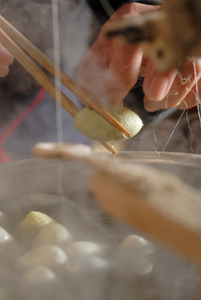Silk: Pure Chinese Lifestyle

If any fabric is associated with China, then it has got to be silk. First developed in ancient China, silks were not just reserved for emperors as gifts, but they helped the Chinese to boost their imagination in religion and artistic expression. Even to this very day, silk is perceived as a perfect reflection of Chinese wisdom and typical lifestyle, as the most ideal representation of nature’s harmony and beauty.

The manufacture of silk has always required that perfect combination of plant, animal and human labour, without which silk simply cannot be produced. A passage in Rites of Zhou (《周礼》Zhōulĭ), ancient Chinese ritual texts listed among the classics of Confucianism (儒学 Rúxué), sums up the importance and significance of this combination:
Only the combination of good timing, proper environment, quality materials and the fine craftsmanship will yield the desirable outcome. Without the first two elements, even the quality materials and the fine craftsmanship will just lead to the undesirable outcome.
Tiān yŏu shí, dì yŏu qì,
天 有 时, 地 有 气,
Cái yŏu měi, gōng yŏu qiăo.
材 有 美, 工 有 巧。
Hé cǐ sì zhě, rán hòu kě yǐ wéi liáng.
合 此 四 者, 然 后 可 以 为 良。
Cái měi gōng qiăo, rán ér bù liáng,
材 美 工 巧, 然 而 不 良,
Zé bù shí, bù dé dì qì yě.
则 不 时, 不 得地气也。
Not only do these words express China’s oldest and most insightful and valuable theory of creation. They can even serve as a guiding philosophy for today’s agricultural production, industrial manufacture and design. This creation theory can perhaps be best illustrated with China’s ancient silkworm breeding and the growing of mulberry.
To date, of all the insects, only silkworms and bees have been domesticated by human beings. Sericulture, the rearing of silkworms, is not only purely manual and self-sufficient, but totally natural and pollution-free. It goes through the unique and virtuous cycle of mulberry growing, mulberry leaf harvest, silkworm breeding, cocoon reeling-off and silk weaving. The whole production process is anything but destructive: it does not slash, smash, beat or cut; nor does it use tools or behaviour reminiscent of these actions. Whilst the Industrial Revolution in the West first saw the development of heavy- duty, loud machines to weave materials, sericulture provides a counterexample, one that enforces lasting peace and harmony, marking coexistence between humans and nature.
Over the course of Chinese history, silk has had varying uses and applications which have evolved over time. In the country’s turbulent Wei and Jin Dynasties (魏晋时期 220-420), for instance, frustrated Chinese officials indulged themselves in drinking, playing music or alchemy. Disappointed at the earthly world, they searched for spiritual uplifting and found it in silk. Thanks to its tenderness and smoothness, silk satisfied the officials’ psychological demands to become supernatural beings, because the light and floating silk clothes gave them the feeling of light-heartedness and freedom.

Back in China’s Tang Dynasty (唐朝 618-907), silk was used in women’s fashion. At a time when plumpness was aesthetically preferred, revealing silk dresses were seen to accentuate women’s curvy breasts and shoulders. The gentle silk and women’s beauty mutually reinforced and complimented each other. But women were not just the wearers of silks; they were also involved in the manufacturing process. Fan Chengda (范成大), one of the best-known poets of the Song Dynasty (宋代 960-1279), reveals in his Four Seasons Pastoral Poem (《四时田园杂兴》Sìshí Tiányuán Záxīng) that women and even children participate in the silk process: tending the land by day and twisting the linen threads by night, all the villagers supporting their families with their own work and skills.
Zhòu chū yún tián yè jì má,
昼 出 耘 田 夜 绩 麻,
Cūn zhuāng ér nǚ gè dāng jiā.
村 庄 儿 女 各 当 家。
In short: silk manufacture was a family affair and the development of sericulture gave birth to China’s traditional mode of family life: the men plough and the women weave. The lifestyle has since become a divine right of common Chinese people. Irrespective of the dynasty, the foundation of the nation and its political power will not collapse, if this right itself is neither challenged nor deprived.
This lifestyle, meeting the basic living conditions of human beings, minimises conflicts between man and nature. For a common Chinese male person, ultimate happiness is achieved by working in sunny fields alongside his wife and children, looking forward to the coming harvest, or watching his wife weaving at night under the light of the lamp.

Silk is a perfect combination of plants,animals and human labour. It is like a beautiful circle which takes the growth of the mulberry leaves, the silkworm’s spinning and manual work to complete. At the end of a silkworm’s life, the raw silk from the worm starts a new life cycle through the work of human beings as real silk, a product. It is a kind of continuation of the creature’s life, but unlike other industries, a product is produced not at the price of killing a creature. In a natural way, with good timing, proper environment, quality materials and fine craftsmanship, the desirable outcome is yielded: silk. Peaceful and harmonious life is, in equal measure, the pursuit of the Chinese as a people. Silk, therefore, reflects ancient wisdom, something that should act as a guide for life in modern-day China.
By Liu Mingjiang (刘明江)
Translated by Gui Tao (桂涛)
Source: Wendao Journal (问道杂志) wendaojournal.com

 Share on Facebook
Share on Facebook Share on Twitter
Share on Twitter Share on LinkedIn
Share on LinkedIn